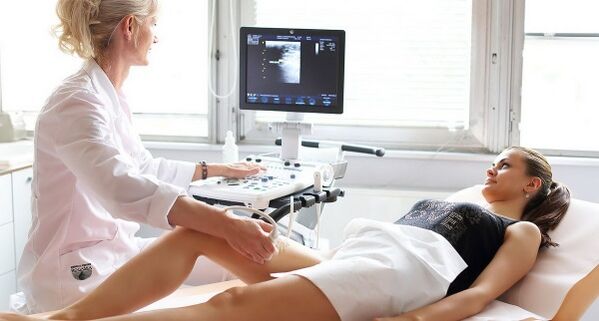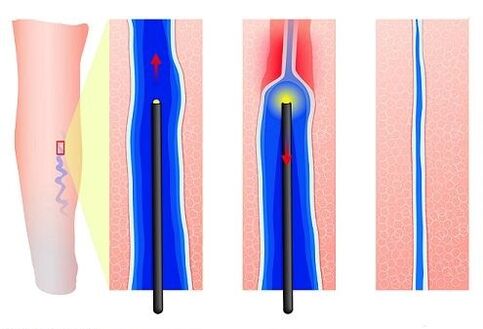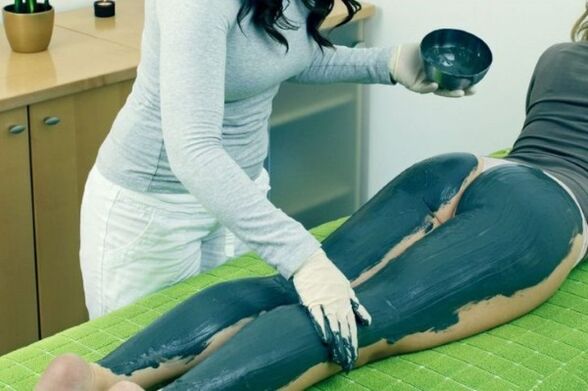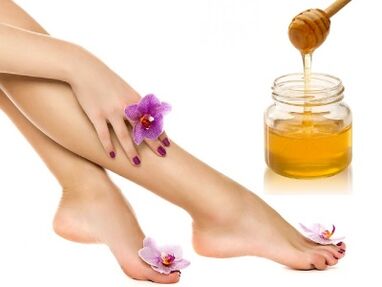Varicosis is a leg disease, which not only disrupts a person's aesthetic appearance, but can also lead to a number of serious complications.The main causes, symptoms and methods of treatment of varicose veins in the legs are described in detail later.

Medical certificate - varicose veins
Varicose veins - a chronic disease of the peripheral veins of the lower extremities with a progressive course.It is characterized by a pathological enlargement of the veins, which is manifested by a violation of the opposite flow of blood in them due to the weakness of the valves and the wall of the vessels.As a result, there is a stagnation of venous blood and an increase in pressure in the veins, the walls of which over time lose elasticity and begin to stretch and deform.According to the International Classification of Diseases, the varicose veins of the ICD-10 of the lower extremities have code 183.
Causes of the disease
The etiology of varicose veins is not well studied.Doctors consider poletiological disease, but distinguish some development theories:
- Mechanical theory. Excessive load on the lower extremities: with work on the foot (surgeon, dentist, teacher, hairdresser), athletes, pregnant women.
- Neuroendocrine theory. Due to hormonal change (pregnancy, menopause, sexual baking), the tone of the vascular walls is reduced.
- Genetic predisposition.Functional congenital valve underdevelopment in the veins.
Risk factors for varicose veins development:
- female gender;
- inheritance;
- Excess weight;
- load load;
- A sedentary lifestyle.

Symptoms of the disease
The manifestations of the disease are:
- The appearance of a vascular mesh in the form of stars on the skin is telangioektasia.
- Skin changes: dryness, pigmentation.In later stages - dermatitis, eczema, trophic ulcers.
- A swollen characteristic through the skin of the justifiable veins in the lower extremities.
- The appearance of pain and disturbance in the legs, especially after physical exercise.Pain can have a different character (pulsating, burning, pain), time of appearance (pain when walking, at the end of the day, at night).
- Development of edema and seizures of beef muscles.At first, the swelling is observed in the region of the foot, then applies to the lower leg.
The stages of the development of varicose veins
The disease develops in stages and slowly.It can pass for several years when its first symptoms appear.
- Phase 0. It is characterized by non -specific traits, such as severity and discomfort in the feet that can be symptoms and other diseases (osteochondrosis, flat feet).At this stage, the disease is also difficult to diagnose due to the lack of main attribute-deformation and the performance of prolonged veins in the foot.
- Stage 1. Changes in the skin - vascular stars are glued to the complaints above.
- Phase 2. Swallowed swollen veins and winding, the nodes are characteristic.
- Stage 3. The appearance of edema is particularly pronounced at the end of the day.
- Stage 4. Manifested by irreversible changes in blood vessels and trophic lesions of the feet due to damaged blood circulation and insufficient tissue nutrition.Strong skin pigmentation (dark brown color) is characteristic.
- Stage 5. Trophic healing ulcers.
- Phase 6. The trophic ulcer is non -healing.
Potential complications

The disease itself is not life -threatening, but its complications are dangerous as a result of premature or improper treatment:
- Acute thrombophlebitis of the surface veins - inflammation of the blood vessel walls, the formation of blood clots by blood clots, which undertook blood circulation in the tissue;
- Pulmonary artery thromboembolism - blockage of the pulmonary artery lumen with a thrombus, which broke away from the ship's wall, often has a death;
- phlebotrombosis;
- Trophic ulcers - occurs with advanced forms of varicose veins due to poor blood tissue nutrition;
- bleeding from the joints.
When you see a doctor
Varicose veins are diagnosed and treated by a phlebologist (cardiovascular surgery).In order not to lose the onset of the disease, it is necessary to contact a specialist in the first signs:
- the emergence of vascular stars on foot;
- a feeling of disturbance in the legs, pain;
- Swelling and rapid fatigue;
- Night convulsions;
- significantly enlarged veins.
The varicose veins in the legs, the treatment of which was timely and effective, to threaten the appearance of complications less.
Diagnostic measures
So far, the main diagnostic method is ultrasound.When diagnosing varicose veins, such measures are performed:
- Ultrasound dopplerography. A method that combines the use of ultrasonic and doppler diagnostics and allows you to evaluate the nature of blood movement through the vessels, the presence of an opposite cast of blood, clotting of the blood, the condition of the cutting vessels, the operation of the venous valves (the presence of flotation) and the periphery patent and deep veins.There are several types: Color Dopplerography, Duplex and Triplex Dopplerography.
- Duplex scan (sonography) is a type of ultrasonic dopplerography, in which 2 methods are used: Dopplerography in mode and color.It allows you to determine the presence of blood clots, their size, the nature of the location, the possibility of separation.The method is not invading, with high accuracy can make a diagnosis and determine further treatment tactics.
- Flebomanometry - a method for determining blood pressure on the vein walls.
- Phleboscintigraphy - inserting a radiofarma in Vienna and observation using a special device.The method is used for the combined vein pathology and the lymphatic system.
- Flebography is a radiological method that implies the introduction of an x -rry contract intravenously.In an X -Ray photo, the doctor will evaluate the condition of the veins.Suitable for the diagnosis of deep veins when ultrasound dopplerography was wrapped.

The last two methods are invading, have a number of contraindications (allergies to a contrast medium) and are rarely used for diagnostic purposes today.
Treatment methods
The varicose veins in the foot, the treatment of which is performed by two main methods in complexes (conservative and surgical), has a favorable prediction.Conservative methods:
- drug treatment;
- the use of traditional medicine;
- physiotherapy;
- Compression therapy involves the use of special underwear;
- Sclerotherapy.
Surgical methods:
- Varadi surgery - removal of affected veins (phlebectomy);
- Laser coagulation of the veins.
External treatment with creams, ointments and gel
External use of creams, ointments and gels acts as auxiliary tools in the early stages of the disease.Preparations help reduce swelling, pain, increase the tone of venous walls.
Laser
Lazamaria treatment (laser coagulation or ablation) is a minimal invasive method used in pronounced forms of the disease.Use laser with different wavelengths.Lazer light enters the vein lumen and climbs its walls.In the future, such a vein will be resolved.The procedure occurs under ultrasound control, does not leave after strong bruises. Advantages of laser treatment: lack of a recovery period, painless and safety of the procedure, a minimum of post -operative complications, wounds and pigments.
Sclerotherapy
Sclerotherapy - is the introduction of a special (sclerosant) medicine into the affected vein, which glues it from the inside and it disappears over time.There are several types of this methodology: Echo-schedrotherapy, microsclerotherapy.The procedure lasts 20 minutes, sclerotherapy sessions required from 3 to 5. This method of treatment is widely used in many countries around the world and provides a long result, and in the initial stages - throughout life.However, with advanced and severe forms, sclerotherapy does not give one hundred percent guarantee.
Hydrotherapy

Treatment of hydrotherapy (water therapy) in the form of different types of baths (with herb, salt) and shower (circular, massage, contrast) contribute to reducing the lumen of blood vessels, help relieve fatigue and swelling of the feet.
Using socks and tights from varicose veins
The use of compression freedom helps in the early stages of varicose veins by eliminating blood stagnation in the peripheral veins and redistributing it from expanded to healthy vessels. The use of such knit linen is possible for preventive purposes and during rehabilitation.
Surgical therapy
Surgical removal of the affected veins - phlebectomy is a radical, complex, but more effective (almost 100% cure) method.However, phlebectomy has a number of contraindications: diseases of the cardiovascular system, liver, kidneys, pregnancy.After surgery, for a month, you need to wear delayed compression linen or apply an elastic bandage on foot.
Physiotherapy
Treatment of varicose veins with physiotherapeutic methods is effective for prevention, in the early stages of the disease, as well as in complex therapy.Widely used: laser therapy, darsonvalization, magnetic laser therapy, pneumocompression, UHF, Balneo and Mudrapy.Physiotherapy helps to strengthen the vascular walls, improves the functioning of valves, microcirulation and lymphocyte in the limbs.A noticeable result is achieved by regular course treatment in combination with other methods of therapy.
Folk remedies
Treatment with folk remedies of varicose veins in the legs is widely popular in patients.However, it should be borne in mind that all methods of non -traditional medicine are ineffective in severe forms of the disease.Popular remedies for the treatment of varicose veins:
- Medicinal plant tinctures: Kalanchoe, nettle, horse chestnut, ginseng root, nutmeg;
- lotions and compresses made of clay, honey;
- Soda baths, sea salt;
- ointments (Vishnevsky);
- Hirudotherapy (treatment with medical caterpillars).
The use of apple cider vinegar

The use of apple cider vinegar for the treatment of varicose veins is recommended by many specialists.It is advisable to cook the product yourself, and not to buy in the store.To prepare vinegar, you need to grind sweet apples, then pour them 3 cm over warm water.Let the product inject for 2 weeks, sometimes stirring with a wooden spoon.Stretch and add a few tablespoons to a glass of rubbing water.Vinegar can be rubbed on the skin of the sore legs, make compresses, wrappers, baths.The tool strengthens the venous wall, improves blood circulation in them, reduces swelling.
Using clay lotions and compresses
Blue clay in the form of lotions and compresses is often used for preventive purposes and with early manifestations of varicose veins. Put the diluted powder with warm water with a thick layer on the foot, wrap it with clinging film and wrap it with a warm scarf.Keep the request for 40 minutes.Or apply for 30 minutes in a gauze affected by a gauze, greasy with chopped garlic clay.Such regular use therapy (a course of 2-3 weeks) effectively facilitates foot discomfort, swelling and fatigue.
Use of acacia flower solution
For the treatment of varicose veins, a color of white acacia colors is used.To prepare it, you need to fill the raw materials in a 3-liter jar and pour 0.5 liters of vodka and medical alcohol into 1/3, cover with lid.Insist a mixture in a dark place for two weeks.Lubricate the sore legs with the finished solution 5-7 times a day.Tincture will help alleviate the symptoms of varicose veins.
Using Ginseng tincture
Ginseng Root is a natural tonic for strengthening venous vessels.The finished tincture can be purchased at a pharmacy or prepared independently by pouring 0.5 liters of 150 g of crushed dry ginseng.Insist the juice in a dark place for 2 weeks.Tincture to get inside an empty stomach 1-2 tablespoons 4 times a day.
The use of nettle
The healing features of nettle have been known for a long time.The plant improves blood circulation, prevents stagnation of blood, strengthens the walls of blood vessels.To prepare the therapeutic nettle simmer, fresh or dried crushed leaves pour a liter of boiling water.Insist a few hours and strain.For a month, drink a decoction of one -third of one glass 3 times a day.
Using potatoes
Effectively, the use of potatoes for varicose veins in the form of compresses, lotions.For compression, mix the freshly launched tube with a spoonful of honey and apply to the injured areas, adjust with a film and bandage on top. Keep a 5 -hour compress and wash with warm water.The course of treatment is 3 weeks. Compressing helps to remove swelling, pain, a vascular network.
Preventing veins with varicose

To prevent the development of varicose veins, it is worth observing the following measures, especially those at risk:
- Keep normal weight;
- Avoid prolonged stay;
- Walk more on foot, do foot exercises;
- Limit the dressing of high head shoes;
- Limit the use of alcohol and cigarettes;
- engage in some kind of sport (swimming, cycling, aerobics);
- water procedures (opposite shower, relaxing baths for the feet);
- Wear compression underwear;
- Respect the right food.
Varicose veins in the foot - treatment and diagnosis - important ingredients of rapid recovery.So far, there are a number of non -traditional drugs and remedies that promise to get rid of varicose veins.
If varicose veins in the legs are not ignored, and the onset of timely treatment, then there is a high percentage of favorable prognosis.In the initial stages, conservative therapy is indicated: medicines, creams, compression tricotions, physiotherapy, traditional medicine recipes.In pronounced forms - laser ablation, removal of advanced veins.

















